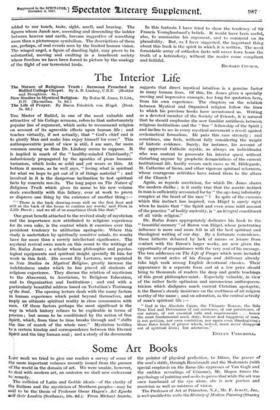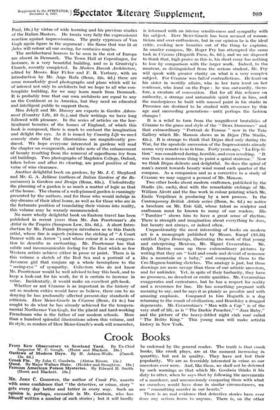Some Art Books
LOT week we tried to give our readers a survey of some of the more important volumes recently issued from the presses of the world in the domain of art. We were unable, however, to deal with modern art, an omission we shall now endeavour to 'remedy.
The collision of Latin and Gothic ideals—of the clarity of the Italians and the mysticism of Northern peoples—may be saki to be the theSis of Professbr Oscar Hagen's Art Epochs aikl their Leaders (Seribners; 10s.- Od.).- From-Michael
the painter of physical perfection, to Darer, the graver of the soul's strife, through Rembrandt and the Modernists (with special emphasis on the flame-like cypresses of Van Gogh and the sudden revealings of Cezanne), Mr. Hagen traces the psychology of painting and seeks to prove that while the art was once handmaid of the eye alone, she is now poetess and musician as well as mistress of vision.
The Professor of Art at Princeton, N.J., Mr. F. Jewett, Jar., is well qualified to write the History of Modern Painting (Stanley Paul, 16s.) by virtue of wide learning and his previous studies of the Italian Masters. He treats very fully the expressionist
reaction against impressionism. The gusty cypresses of Van Gogh again figure in the argument : the flame that was lit at Arks will colour all our seeing, for centuries maybe.
The architectural horrors to be seen in the rest of Europe are absent in Denmark. The Town Hall at Copenhagen, for instance, is a very beautiful building, and so is Gruntvig's
Church, recently completed. In Modern Danish Architecture, edited by Messrs. Kay Ficker and F. R. Yerbury, with an
introduction by Mr. Aage Rafu (Benn, 32s. 6d.) there are some remarkably good photographs and plans which will be of interest not only to architects but we hope to all who con- template building, for we may learn much from Denmark. It is probably true that our own architects are equal to any on the Continent or in America, but they need an educated and intelligent public to support them.
Miss Jekyll and Mr. Hussey are experts in Garden Adorn- ment (Country Life, £3 3s.), and their writings we have long
followed with pleasure. In the series of articles on the hor- ticultural beauties of the homes of England, of which this book is composed, there is much to enchant the imagination
and delight the eye. As it is issued by Country Life we need
scarcely state that the illustrations are magnificently pro- duced. We hope every one interested in gardens will read the chapter on overgrowth, and take note of the enhancement of beauty resulting from the removal of superfluous ivy from old buildings. Two photographs of Magdalen College, Oxford, taken before and after its clearing, are proof positive of the value of wise clearance.
Another delightful book on gardens, by Mr. J. C. Shepherd and Mr. G. A. Jellicoe (authors of Italian Gardens of the Re- naissance) is Gardens and Design (Benn, 63s.). Undoubtedly
the planning of a garden is as much a matter of logic as that of the house. The charm of a well-planned garden is cunningly presented by the authors, and for those who would indulge in day-dreams of their ideal home, as well as for those who are in the fortunate position of translating their visions into reality, this volume may be warmly recommended.
No more wholly delightful book on Eastern travel has been published in recent years than Mr. Jan Poortenaar's An
Artist in the Tropics (Sampson Low, 31s. 6d.). A short Intro-
duction by Mr. Frank Brangwyn introduces us to this Dutch artist, whose line is superb (witness the etching of " A Court Dancer with an Arrow ") and whose colour it is no exaggera- tion to describe as enchanting. Mr. Poortenaar has that subtle and incommunicable feeling for the East which so few Western artists achieve either in prose or paint. There is in this volume a sketch of the Red Sea and a portrait of a Javanese girl that conjure up a whole hemisphere to the " seeing-eye " of sympathy. Collectors who do not know Mr. Poortenaar would be well advised to buy this book, and to keep a look-out for his work, for it is certain to increase in value. Incidentally, it would make an excellent gift-book.
Whether or not Cezanne is as important in the history of art as modern critics would have us believe, there can be no
denying he has profoundly affected present-day standards of criticism. Herr Meier-Graefe in Cezanne (Benn, £4 4s.) has sought to do what he has already achieved for the tempera- mental Northerner Van Gogh, for the placid and hard-working Frenchman who is the father of our modern schools. More than a hundred splendid illustrations adorn this volume, and its style, as readers of Herr Meier-Graefe's work will remember, is informed with an intense sensitiveness and sympathy with his subject. Herr Meier-Graefe has been accused of roman- ticism and over-enthusiasm, but in our opinion he is the ideal critic, evoking new beauties out of the thing lie explains. In smaller compass, Mr. Roger Fry has attempted the same task in C'ezanne (Hogarth Press, 8s. 6d.), and we arc disposed to think that, high praise as this is, his short essay has nothing to lose by comparison with the larger work. Indeed, to the amateur, as distinguished from the serious student, Mr. Fry will speak with greater clarity on what is a very complex subject. For Cezanne was full of contradictions. He leant on his sister in worldly affairs, who in her turn leant on her confessor, who leant on the Pope : he was outwardly, there- fore, a creature of convention. But for all this reliance on authority, a strange and untamable spirit lived in him, and the masterpieces he built with massed paint in his studio in Provence are destined to be studied with reverence by this age and succeeding generations—until perhaps the fashion changes !
It is a relief to turn from the magnificent brutalities of Cezanne to the grace and style of the " Deux Danseuscs" and that extraordinary " Portrait de Femme " now in the Tate Gallery which Mr. Manson shows us in Degas (The Studio, 42s.). It is strange to think- that Degas died only during the War, for the apostolic succession of the Impressionists already seems very remote to us in time. Forty years ago, " La Rep ti- tion" was considered daring, horrible, and even revolting. It was then a monstrous thing to paint a spiral staircase." Now we think Degas delicate and delightful. So does the spiral of man's ascent towards beauty wind round each quarter of the compass. As a companion and as a corrective to a study of Cezanne we may suggest a perusal of Mr. Manson.
Two other books about modern craftsmen, published by the Studio (5s. each), deal with the remarkable etchings of Mr. William Alcott and the fine work in colour printing which Mr. Emile Verpilleux is producing by a new process. In the Contemporary British Artists series (Benn, 8s. 6d.) we notice a brochure on Mr. Eric Gill, whose talent as sculptor and craftsman must be known to many of our readers. His " Tumbler " shows him to have a great sense of rhythm. There is strength and imagination about everything lie does, but beauty not always, or indeed often.
Unquestionably the most interesting of books on modern art is a monograph published by Messrs. Knopf ($3.50) entitled Negro Drawings, illustrating the work of that young and enterprising Mexican, Mr. Miguel Covarrubias. Mr. Ralph Barton sums up these extraordinary pictures by writing that they are " bald and crude and devoid of nonsense like a mountain or a baby," and comparing them to the Cro-Magnon hunting sketches. The analogy is just, but these drawings are more savage than those of our artistic ancestors, and far unkinder. Yet, in spite of their barbarity, they have no grossness, no decadent or erotic qualities. Mr. Covarrubias exaggerates and caricatures, but he has a respect for reality and a reverence for line. He has something pregnant with meaning to say, and he says it as plainly as possible and with amazing emphasis. Compared to him Hogarth is a dog returning to the vomit of civilization, and Beardsley a drugged degenerate. Mr. Covarrubias's " Man with a Cap " is of the very stuff of life, as is " The Darkie Preacher," " Jazz Baby," and the picture of the heavy-lidded night club roue called " The Bolito King." This young man will make artistic history in New York.











































































 Previous page
Previous page